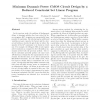Free Online Productivity Tools
i2Speak
i2Symbol
i2OCR
iTex2Img
iWeb2Print
iWeb2Shot
i2Type
iPdf2Split
iPdf2Merge
i2Bopomofo
i2Arabic
i2Style
i2Image
i2PDF
iLatex2Rtf
Sci2ools
VLSID
2003
IEEE
2003
IEEE
Minimum Dynamic Power CMOS Circuit Design by a Reduced Constraint Set Linear Program
In the previous work, the problem of nding gate delays to eliminate glitches has been solved by linear programs (LP) requiring an exponentially large number ofconstraints. By introducing two additional variables per gate, namely, the fastest and the slowest arrivaltimes, besides the gate delay, we reduce the number of the LP constraints to be linear in circuit size. For example, the 469-gate c880 circuit requires 3,611 constraints as comparedto the 6.95millionconstraints needed with the previous method. The reduced constraints provably produce the same exact LP solution as obtained by the exponential set of constraints. For the rst time, we are able to optimizeall ISCAS'85 benchmarks. For the c7552 circuit, when the input to output delay is constrained not to increase, a design with 366 delay bu ers consumes only 34% peak and 38% average power as compared to an unoptimized design. As shown in previous work, the use of delay bu ers is essential in this case. The practicality of th...
Related Content
| Added | 01 Dec 2009 |
| Updated | 01 Dec 2009 |
| Type | Conference |
| Year | 2003 |
| Where | VLSID |
| Authors | Tezaswi Raja, Vishwani D. Agrawal, Michael L. Bushnell |
Comments (0)

